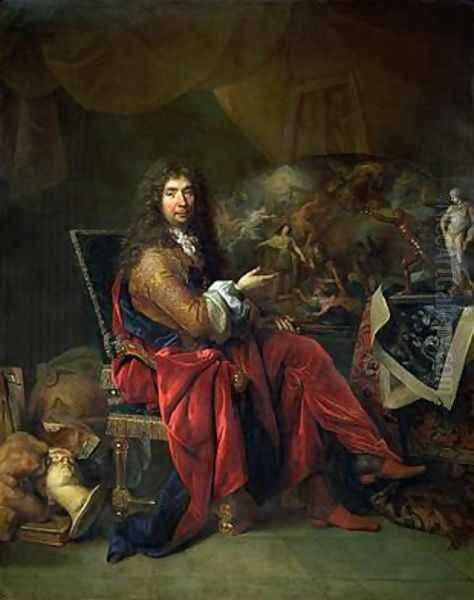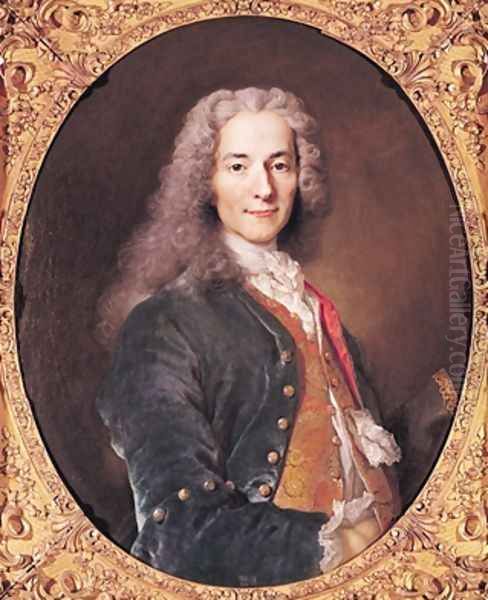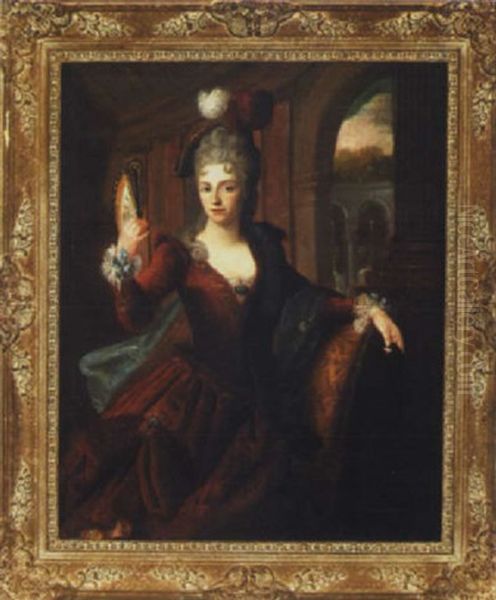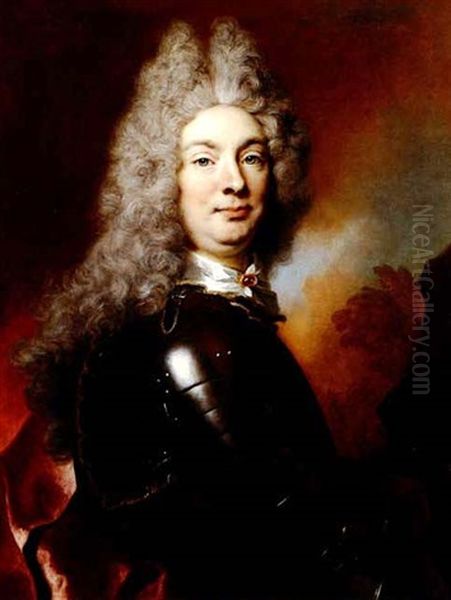
Nicolas de Largillière stands as a pivotal figure in French art history, a prolific painter whose career spanned the opulent final decades of Louis XIV's reign and the burgeoning Rococo era under Louis XV. Renowned primarily for his masterful portraits, he also excelled in history painting and still life, leaving behind a rich legacy that blended Flemish warmth with French elegance. His life, marked by international training and significant recognition within the French academic system, offers a fascinating glimpse into the artistic and social world of the late 17th and early 18th centuries.
Early Life and Flemish Foundations
Born in Paris on October 10, 1656, Nicolas de Largillière's artistic journey began not in his native city, but in Antwerp. His father, recorded variously as a merchant or a carpenter, relocated the family to the vibrant Flemish port city when Nicolas was just three years old. Antwerp, a major artistic hub still echoing with the influence of giants like Peter Paul Rubens and Anthony van Dyck, provided the fertile ground for Largillière's initial artistic development.
He entered the studio of Antoine Goubau (also spelled Goubeau), a painter known for his market scenes and still lifes. This early training instilled in Largillière a deep appreciation for rich color, textural detail, and the robust naturalism characteristic of the Flemish school. The influence of Rubens and Van Dyck, particularly their dynamic compositions and expressive handling of paint, would remain discernible throughout his long career, lending a distinctive warmth and vitality to his later French works. These formative years in Antwerp laid a crucial technical and stylistic foundation.
The London Interlude: Court Style and Intrigue
Seeking broader horizons, the young artist traveled to England around 1675. He spent a period, estimated between two to four years according to different accounts, working in London. Crucially, he found employment in the studio of Sir Peter Lely, the dominant portrait painter at the court of King Charles II. Lely, himself of Dutch origin but thoroughly integrated into the English aristocratic style pioneered by Van Dyck, provided Largillière with invaluable experience in the art of court portraiture.

During his time with Lely, Largillière reportedly worked on restoring paintings at Windsor Castle and perhaps contributed to Lely's own studio output. His talent did not go unnoticed; King Charles II himself is said to have appreciated his work. This English sojourn exposed him to a different facet of Baroque portraiture – one emphasizing elegance, refined poses, and the depiction of luxurious fabrics, elements he would later adapt within his own practice. However, his time in England was cut short by the political and religious turmoil surrounding the Rye House Plot in 1683, an alleged conspiracy against the King. As a Catholic, Largillière likely felt vulnerable amidst the ensuing anti-Catholic sentiment, prompting his return to France.
Establishing a Parisian Reputation
Returning to Paris around 1679-1683, Largillière arrived with a unique blend of Flemish richness and English courtly style. He quickly set about establishing himself in the competitive Parisian art world. The artistic scene was then dominated by Charles Le Brun, the powerful Premier Peintre du Roi (First Painter to the King) and director of the Académie Royale de Peinture et de Sculpture (Royal Academy of Painting and Sculpture). While not a direct student, Largillière undoubtedly absorbed the influence of the prevailing French academic style championed by Le Brun, which emphasized classical composition and decorum.
Largillière's distinct style, however, set him apart. His ability to combine flattering likenesses with vibrant color and a sense of immediacy appealed to a growing clientele beyond the immediate circle of the royal court. He found particular favor with the Parisian bourgeoisie – magistrates, financiers, city officials (échevins) – as well as members of the aristocracy who perhaps sought a less formal, more lively style than that offered by some contemporaries. His reputation grew steadily through the 1680s.
The Height of Success: Portraitist to the Elite
The late 17th and early 18th centuries marked the zenith of Largillière's career. He became one of the most sought-after portrait painters in Paris. His success lay in his remarkable versatility and his keen understanding of his sitters' desires. He could execute grand, formal state portraits imbued with authority, intimate private likenesses capturing individual personality, and allegorical portraits that cast his subjects in mythological or historical guise.
His clientele included prominent figures from the royal family, the nobility, the judiciary, the financial world, fellow artists, and intellectuals. He painted members of Louis XIV's family, capturing the grandeur of the era. Though specific commissions like a portrait of "Marie de' Medici" for Louis XIV mentioned in some sources are historically inaccurate regarding the sitter's identity for that period, he certainly painted key figures associated with the court, possibly including James Francis Edward Stuart (the "Old Pretender") and his family during their exile in France.

Largillière possessed an exceptional ability to render the textures of luxurious fabrics – silks, velvets, lace, and brocades – with dazzling virtuosity. His portraits are often characterized by rich, deep colors, dynamic poses that suggest movement or interaction, and a sensitivity to the sitter's psychology. He masterfully balanced the need to convey social status with the desire to capture a lifelike presence, making his portraits both impressive and engaging.
Artistic Style: A Fusion of Influences
Largillière's mature style represents a sophisticated synthesis of the various artistic currents he encountered. The Flemish foundation remained evident in his warm color palette, often featuring rich reds, golds, and deep blues, and in his robust handling of paint. The influence of Rubens can be seen in the energy and dynamism of some compositions, while the elegance and refinement learned from Van Dyck and Lely are apparent in the graceful poses and sophisticated portrayal of his sitters.
To this, he added a distinctly French sensibility, aligning with the grandeur of the Baroque era under Louis XIV but gradually incorporating a lighter touch that anticipated the Rococo style emerging during the Régence and the reign of Louis XV. He excelled at capturing the play of light on surfaces, creating a sense of atmosphere and depth. His brushwork, while capable of fine detail, often retained a lively, visible quality that added to the vibrancy of his canvases. He was less rigidly classical than some of his French contemporaries, allowing for more naturalism and psychological insight.
Representative Masterpieces
Largillière's vast output includes numerous works that exemplify his skill and style. Among his most celebrated paintings are:
Portrait of Charles Le Brun (c. 1683-1686): His reception piece for the Royal Academy, this imposing portrait of the Academy's director not only demonstrated his technical prowess but also strategically positioned him within the French art establishment. It showcases his ability to convey authority and intellectual depth.
The Family of Le Brun (Date uncertain, Louvre): Not to be confused with the portrait of Charles Le Brun, this work (likely depicting a different Le Brun family, perhaps the artist's own patrons or friends) is often cited for its masterful handling of color, light, and complex group composition, demonstrating his skill beyond single portraits.
La Belle Strasbourgeoise (The Beautiful Woman of Strasbourg) (1703, Musée des Beaux-Arts, Strasbourg): A captivating portrait, possibly of a relative or acquaintance, admired for its direct gaze, charming depiction of regional costume, and vibrant execution. It highlights his ability to capture individual character with warmth.

Self-Portrait with his Wife and Daughter (c. 1705-1710): An intimate glimpse into the artist's personal life, showcasing his skill in group portraiture and conveying familial affection within an elegant setting.
Portrait of Louis XIV and His Heirs (c. 1710, Wallace Collection, London): A significant royal commission depicting the aging monarch with his son (the Grand Dauphin) and grandson (the Duke of Burgundy), symbolizing dynastic continuity. It blends formality with a degree of psychological insight.
Portrait of Augustus II, King of Poland and Elector of Saxony (c. 1715): Demonstrates his international clientele and his ability to capture the regal bearing of powerful European rulers.
Portrait of Voltaire (1718): An early portrait of the famed Enlightenment writer as a young man (then known as François-Marie Arouet). It is noted for its lively characterization and foreshadows the intellectual energy Voltaire would become known for.
These examples illustrate the range of his portraiture, from official state images to more personal depictions, all marked by his characteristic blend of technical skill and expressive vitality.
Beyond Portraiture: History, Allegory, and Still Life
While portraiture formed the bedrock of his fame and fortune, Largillière was ambitious to prove his merit in the more highly esteemed genre of history painting, as required for full status within the Academy. His reception piece was technically a history painting (the portrait of Le Brun being accepted as such due to the sitter's importance). He also painted historical and allegorical subjects, often integrating portraits within them.
One notable example is the large group portrait, The Prévôt and Aldermen of the City of Paris Deliberating (1687, destroyed, sketch survives in the Louvre), commissioned for the Paris City Hall (Hôtel de Ville). This work combined portraiture with the narrative demands of a historical event, showcasing his ability to manage complex compositions with numerous figures. He also painted religious subjects, such as a version of Christ's Entry into Jerusalem, demonstrating his capacity across different thematic areas.

Furthermore, his early training with Goubau left him with a lasting interest and skill in still life painting. Though less numerous than his portraits, his still lifes, often featuring flowers, fruit, or musical instruments (like Still Life with a Violin), are admired for their rich textures, vibrant colors, and meticulous detail, echoing the Flemish tradition. Upon his death, he bequeathed some of his small landscapes and still lifes to the French state, indicating his personal regard for these genres.
The Royal Academy: Recognition and Leadership
Largillière's relationship with the Académie Royale de Peinture et de Sculpture was central to his career. He was officially received (agréé) in 1683 and became a full member (reçu) as a history painter upon presentation of his portrait of Charles Le Brun, likely around 1686. Membership conferred prestige and access to royal commissions.
He actively participated in the Academy's activities and exhibitions (Salons). His reputation continued to grow, and he ascended through the institution's ranks. His long service and esteemed position culminated in his appointment as Director of the Academy in 1743, the highest honor within the French art establishment. He held this prestigious post until his death in 1746, cementing his status as a leading figure of his generation.
Teaching and Influence: Shaping the Next Generation
As a prominent Academician and later Director, Largillière played a significant role in educating younger artists. His studio was an important training ground. Among his most notable pupils were:
Jean-Baptiste Oudry (1686-1755): Initially trained by his father, Oudry spent about five years in Largillière's studio. While Oudry would become famous for his animal paintings, hunting scenes, and still lifes, his early career included portraiture, clearly showing the influence of his master's style and technique. Oudry himself became an important Academician.
Alexandre Roslin (1718-1793): This Swedish painter spent time in Paris and was influenced by the leading portraitists, including Largillière, whose rich color and textural detail are echoed in Roslin's own successful international career.
Jacob van Schuppen (1670-1751): Born in Paris but of Flemish descent, Van Schuppen was influenced by his uncle Largillière (though perhaps not a formal pupil in the strictest sense) before achieving success, notably as director of the Vienna Academy.
Jean-François Delyen (1684-1761): A Flemish painter who worked in Paris and was recorded as a student of Largillière.
Gustaf Lundberg (1695-1786): Another Swedish artist who studied in Paris, primarily known for his pastels, he absorbed influences from the Parisian art scene, including the work of Largillière.

Through his teaching and the example of his work, Largillière influenced the development of French portraiture, helping to transmit the rich traditions of the Baroque while adapting to the evolving tastes of the early 18th century.
Contemporaries and the Artistic Milieu
Largillière worked during a vibrant period in French art, interacting with and competing against numerous talented contemporaries. His career overlapped with:
Hyacinthe Rigaud (1659-1743): Largillière's main rival in the field of formal portraiture. While both were highly successful, Rigaud is perhaps more associated with the grand, official portraits of Louis XIV and the highest aristocracy, often emphasizing majestic formality. Largillière, while capable of grandeur, often brought a greater warmth and accessibility, particularly favored by the Parisian elite and bourgeoisie.
François de Troy (1645-1730): Another prominent portrait painter, known for his elegant depictions of society figures. Sources suggest Largillière and de Troy sometimes painted the same sitters, indicating the competitive yet interconnected nature of the Parisian art market.
Antoine Coypel (1661-1722): A leading history painter who also produced portraits, representing the more classical, academic tradition influenced by Le Brun.
Pierre Mignard (1612-1695): A dominant portraitist before Rigaud and Largillière rose to prominence, Mignard succeeded Le Brun as First Painter to the King. Largillière's early Parisian career developed in the context set by Mignard's established style.
Joseph Vivien (1657-1734): A noted portraitist, particularly known for his work in pastels.
Largillière navigated this competitive landscape successfully, carving out a distinct niche through his unique blend of influences and his appeal to a broad range of patrons. His work forms a bridge between the formal Baroque of Louis XIV's reign, exemplified by Le Brun and Rigaud, and the lighter, more intimate Rococo style that would flourish with artists like Jean-Antoine Watteau (1684-1721), François Boucher (1703-1770), and Jean-Honoré Fragonard (1732-1806), whose careers were beginning or developing as Largillière's was concluding. While distinct from the Rococo masters, Largillière's later works sometimes show a softening palette and increased intimacy that hint at the changing aesthetic.
Personal Life: Family and Collection

Details about Largillière's personal life suggest a man deeply embedded in the world of art. In 1699, he married Marguerite-Élisabeth Forest, the daughter of the landscape painter Jean Forest. Marguerite-Élisabeth was herself reportedly a painter, indicating a shared artistic environment within the family. They had children, including a daughter depicted in some of his self-portraits. Some sources mention his mother having a Jewish background, adding another layer to his diverse cultural heritage, though this is not always prominently cited in mainstream biographies.
Beyond his own painting, Largillière was an avid art collector. At the time of his death, his personal collection reportedly numbered over five hundred paintings and drawings, encompassing his own works as well as those by other artists, both contemporary and Old Masters. This extensive collection underscores his deep engagement with art history and his support for fellow artists, reflecting a life dedicated to the visual arts in all its forms.
Final Years and Enduring Legacy
Nicolas de Largillière remained active as a painter well into his old age, a testament to his enduring energy and reputation. He continued to receive commissions and participate in the Academy, serving as its Director from 1743. He died in Paris on March 20, 1746, at the venerable age of 89, having witnessed profound changes in French art and society over his long lifetime.
His death was followed by an estate sale that revealed the extent of his collection and the high regard in which his own works were held. His paintings were sought after by both aristocratic and bourgeois collectors. His influence persisted through his students and through the enduring appeal of his portraits, which captured the likenesses of a generation of French society.
Today, Nicolas de Largillière is recognized as one of the most important French painters of the Baroque era. He is particularly celebrated for elevating portraiture through his technical brilliance, his psychological insight, and his ability to blend diverse European artistic traditions. His works are prominently displayed in major museums worldwide, including the Louvre in Paris, the Palace of Versailles, the Wallace Collection in London, the Metropolitan Museum of Art in New York, and the National Gallery of Art in Washington D.C., ensuring his contribution to art history remains visible and appreciated. He stands as a master technician, a sensitive observer of humanity, and a key figure bridging the grandeur of the Grand Siècle with the emerging sensibilities of the Enlightenment.